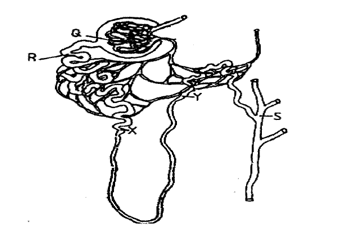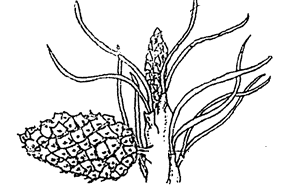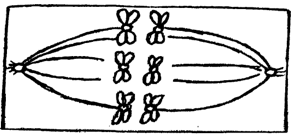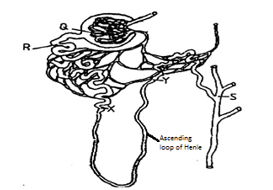INSTRUCTIONS
3. Answer all questions in the spaces provided
4. Mathematical tables and silent electronic calculators may be used
5. All working must be clearly shown where necessary

QUESTIONS
- State the name given to the study of: (2marks)
- Chemical changes in living organisms.
- Insects.
- State the category of variation into which the following traits fall. (2marks)
- Skin pigmentation.
- Blood group .
- Give two possible genotypes of blood group A. (2marks)
- Give two differences between scientific names and common names. (2marks)
Scientific Names
Common Names
- Explain two adaptation that enable the halophytes to survive in their habitats. (2marks)
-
- What is parthenogenesis. (1mark)
- Monocotyledonous plants do not undergo secondary growth. Explain, (1mark)
- Name two classes of Phylum Arthropoda whose members’ head is fused with the thorax. (2marks)
- Name two excretory products produced by both plants and animals. (2marks)
- The shirt of a student was stained by a solution of DCPIP. A friend advised him to wash with lemon juice. Explain. (1mark)
- Two freshly cut banana peels A and B measuring 4cm long were cut, which were later placed in solutions of different concentrations in two separate beakers for 30minutes. The appearance after 30minutes is as shown below.

- What is the nature of the solution in which piece B was placed. (1mark)
- Account for the appearance of piece A. (3marks)
-
- The ovum is fertilized only by one sperm yet there is millions of sperm surrounding the ovum. Explain. (1mark)
- Give the role of the following parts of the male reproductive system.
- Epididymis (1mark)
- Prostate gland (1mark)
- When a person has oxygen debt the heart beat increases. Give two importance of the increase in heart beat. (2marks)
- The diagram below shows part of a nephron from the human kidney.

- Give two factors that lead to creation of higher pressure in the structure labelled Q. (2marks)
- On the diagram above label the part where the sodium ions are reabsorbed and write down the hormone involve in regulating the level of this ions (2marks)
Name of the hormone; ………………………………………………………………………………
- Explain how the following parts of a light microscope are modified to perform their function
- Diaphragm (1mark)
- Mirror. (1mark)
-
- Explain two adaptations of cell membrane to its function. (2marks)
- Why is oxyhaemoglobin formation is highly preferred during transportation of oxygen in the body. (2marks)
-
- Explain how smoking of tobacco lead to lung cancer. (1mark)
- How does age affect the breathing rate in human? (2marks)
- In an experiment to investigate an aspect of digestion, two test tubes A and B were set as shown below. The set up was left for 30 minutes and the temperature of water was maintained at 37°C.

The resulting content in each test tube A and B were placed into two separate visking tubing which were then placed in a beaker containing iodine solution, for 20 minutes.- What was the observation that was made in the visking tubing containing contents of test tube A. (1mark)
- Account for the result in visking tubing which was containing contents of test tube B. (3marks)
- During a biological excursion a group of form 4 students collected plant specimen whose reproductive organ is shown below.

- Name the sub-division of the plant in which the above specimen was obtained. (1mark)
- Other than the presence of the above characteristics, state two characteristics of plants in the sub-division named above. (2marks)
- Enzymes are important in various physiological processes in living things.
- Differentiate between an enzyme and a hormone (1mark)
- Name one property of an enzyme exhibited by the lock and key hypothesis (1mark)
-
- The transverse section of a young dicotyledous root was cut and iodine solution was applied. One of the part of the section turned to blue-black colour. Identify the part of the root and give a reason for your answer.
Part ………………………………………………………………………………………… (1mark)
Reason (1mark) - Distinguish between transpiration and guttation. (1mark)
- The transverse section of a young dicotyledous root was cut and iodine solution was applied. One of the part of the section turned to blue-black colour. Identify the part of the root and give a reason for your answer.
- The diagram below shows a cell undergoing a stage in cell division.

With a reason, identify this stage (2mark)
Identify
Reason -
- Define the term immunity. (1mark)
- Identify one immunizable disease in Kenya (1mark)
- State two ways in which lymphocytes kill disease causing microorganism. (2marks)
- Study the diagram below and answer the questions that follow.

- With an arrow, indicate on the diagram the direction of the impulse through the neuron. (1mark)
- State the function of the parts labelled P (1mark)
- Name the type of response exhibited by;
- Sperm cell when it swims towards the ovum. (1mark)
- Leaves of Mimosa pudica when they fold their leaves after being touched. (1mark)
-
- Distinguish between hypogeal and epigeal germination. (1mark)
- State two internal factors necessary for germination (2marks)
-
- Give two importance of divergent evolution to animals (2marks)
- Explain two limitations of fossil record as an evidence for evolution (2marks)
- What causes the following diseases?
- Diabetes mellitus (1mark)
- Diabetes inspidus (1mark)
- Study the diagram below and answer the questions that follows.

- Identify the tooth. (1mark)
- Give a reason for your answer in 27(a) above (1mark)
- State two mineral ions deposited on the bones to harden them. (2marks)
-
- The following is food chain that was presented by a student in class.

State two errors that are made in the food chain (2marks) - Give a reason why pyramid of biomass is considered to be more accurate over the pyramid of numbers. (1mark)
- The following is food chain that was presented by a student in class.
- Below are cross section of diagrams of fruits.
Identify the type of placentation present in the three diagrams (3marks)
P ……………………………………………………………….
Q ……………………………………………………………….
R ……………………………………………………………….

MARKING SCHEME
- State the name given to the study of: (2marks)
- Chemical changes in living organisms
- Biochemistry ;
- Insects
- Entomology ;
- Chemical changes in living organisms
- State the category of variation into which the following traits fall. (2marks)
-
- Skin pigmentation
- Continuous ;
- Blood group
- Discontinuous
- Skin pigmentation
- Give two possible genotype of blood group A (2marks)
- AA, AO;
-
- Give two differences between scientific names and common names. (2marks)
Scientific Names
Common Names
Universally known
Known only in local areas ;
Written in Latin language
Written in local languages ;
- Explain two adaptation that enable the halophytes to survive in their habitats. (2marks)
- Root cell with high salt concentration to offset the osmotic imbalance;
- Some have glands that secrete excess salt ;
- Possess succulent tissues for water storage ;
- Mangrove has pneumatophores emerging above water to obtain air;
Any first 2 correct
-
- What is parthenogenesis (1mark)
- Asexual reproduction in which the unfertilized egg is produced and hatch into adult insect,,
- Monocotyledonous plants do not undergo secondary growth. Explain (1mark)
- Lack cambium ;
- What is parthenogenesis (1mark)
- Name two classes of Phylum Arthropoda whose members’ head is fused with the thorax (2marks)
- Class Crustacea;
- Class Arachnida ;
- Name two excretory products produced by both plants and animals (2marks)
- Carbon (IV) oxide;
- Water ;
- The shirt of a student was stained by a solution of DCPIP. A friend advised him to wash with lemon juice. Explain. (1mark)
Lemon juice contains ascorbic acid/vitamin C which decolourizes DCPIC; - Two freshly cut banana peels A and B measuring 4cm long were cut, which were later placed in solutions of different concentrations in a beaker for 30minutes. The appearance after 30minutes is as shown below.
- What is the nature of the solution in which piece B was placed (1mark)
- Hypotonic solution ;
- Account for the appearance of piece A (3marks)
- The banana peel was placed in a hypertonic solution, the mesocarp cells loose water by osmosis; becoming flaccid, reducing in size thus the curvature; the outer side is covered by the waterproof cuticle hence do not loose water by osmosis;
- What is the nature of the solution in which piece B was placed (1mark)
-
- The ovum is fertilized only by one sperm yet there is millions of sperm surrounding the ovum. Explain (1mark)
- After fertilization the vitelline membrane changes its structure preventing any other sperm from entering the ovum;
- Give the role of the following parts of the male reproductive system
- Epididymis (1mark)
- Storage of sperms ;
- Prostate gland (1mark)
- Produce alkaline fluid that neutralizes vaginal fluid/ activates sperms;
- Epididymis (1mark)
- The ovum is fertilized only by one sperm yet there is millions of sperm surrounding the ovum. Explain (1mark)
- When a person has oxygen debt the heart beat increases. Give two importance of the increase in heartbeat (2marks)
- Enhances faster supply of oxygen needed to breakdown the lactic acid;
- Transport lactic acid to the liver(converted to glycogen);
- The diagram below shows part of a nephron from the human kidney.
- Give two factors that lead to creation of higher pressure in the structure labelled Q(2marks)
- The efferent has a narrower lumen than the afferent ;
- Renal artery branches directly from the aorta whose flows at higher pressure ;
- On the diagram above label the part where the sodium ions are reabsorbed and write down the hormone involve in regulating the level of this ions (2marks)

Name of the hormone; Hormone Aldosterone;
- Give two factors that lead to creation of higher pressure in the structure labelled Q(2marks)
- Explain the following parts of a light microscope are modified to perform their function
- Diaphragm (1mark)
- Has adjustable aperture thus able to regulate amount of light passing through the condenser;
- Mirror (1mark)
- Shinny surface for reflecting light through the condenser onto the stage / Adjustable to change in position for efficient reflection of the light from the surrounding ;
- Diaphragm (1mark)
-
- Explain two adaptations of cell membrane to its function (2marks)
- Tiny spores for selective movement of materials in and out of the cell;
- Has two phospholipid layers embedded to protein molecule, which strengthens it to enclose the cell contents;
- Why is oxyhaemoglobin formation is highly preferred during transportation of oxygen in the body. (2marks)
- Oxyhaemoglobin is unstable compound which readily dissociates to release oxygen; creating room for transportation of more oxygen ;
- Explain two adaptations of cell membrane to its function (2marks)
-
- Explain how smoking of tobacco lead to lung cancer (1mark)
- Burning tobacco has tar which triggers lung cells to become cancerous;
- How does age affect the breathing rate in human? (2marks)
- Younger people have higher breathing rate than aged people; since they are actively growing thus require more oxygen for respiration which provide energy for cell division;
- Explain how smoking of tobacco lead to lung cancer (1mark)
- In an experiment to investigate an aspect of digestion, two test tubes A and B were set as shown below. The set up was left for 30 minutes and the temperature of water was maintained at 370C.
The resulting content in each test tube A and B were placed into two separate visking tubing which were then placed in a beaker containing iodine solution.- What was the observation that was made in the visking tubing containing contents of test tube A. (1mark)
- Content in the visking tubing turned to brown colour;
- Account for the result in visking tubing which was containing contents of visking tubing B (3marks)
- Content in the visking tubing B turned to blue black colour; iodine has small molecules thus diffused through the visking tubing reacting with starch forming the blue black substance; starch has larger molecule hence unable to pass through the tiny pores of the visking tubing ;
- What was the observation that was made in the visking tubing containing contents of test tube A. (1mark)
- During a biological excursion a group of form 4 students collected plant specimen whose reproductive organ is shown below.
- Name the sub-division of the plant which the above specimen was obtained. (1mark)
- Gymnospermaphyta;
- Other than the presence of the above characteristics, state two characteristics of plants in the sub-division named above. (2marks)
- Presence of needle like leaves/ show xerophytic characteristics / Non-flowering /Xylem made up of mainly tracheids / Phloem lack companion cells; Any first 2 correct
- Name the sub-division of the plant which the above specimen was obtained. (1mark)
- Enzymes are important in various physiological processes in living things.
- Differentiate between an enzyme and a hormone (1mark)
- Enzymes are organic catalysts which regulate biochemical reactions in the body cell, while hormone are organic compounds which influence biological activities;
- Name one property of an enzyme exhibited by the lock and key hypothesis (1mark)
- Substrate specific;
- Differentiate between an enzyme and a hormone (1mark)
-
- The transverse section of a young dicotyledous root was cut and iodine solution was applied. One of the part of the section turned to blue-black colour. Identify the part of the root and give a reason for your answer.
Part (1mark)- Endodermis;
Reason (1mark) - Has starch grains which stain blue-black with iodine solution;
- Endodermis;
- Distinguish between transpiration and guttation (1mark)
- Transpiration is the process by which plant lose water inform of water vapour through the stomata, while guttation plant lose water in form of droplets through hydathodes;
- The transverse section of a young dicotyledous root was cut and iodine solution was applied. One of the part of the section turned to blue-black colour. Identify the part of the root and give a reason for your answer.
- The diagram below shows a cell undergoing a stage in cell division.
- With a reason, identify this stage (2mark)
- Identify Metaphase I rej. Metaphase alone ;
- Reason Bivalent chromosomes lie up together at the equator ;
-
- Define the term immunity. (1mark)
- Ability of the body to develop resistance against disease causing microorganisms in the body ;
- Identify one immunizable disease in Kenya (1mark)
- Measles /Polio/Tetanus /Whooping cough /Pneumonia;
- State two ways in which lymphocytes kill disease causing microorganism. (2marks)
- Antitoxins neutralized the toxins /Agglutinins causes crumping together of the disease causing microorganisms /Lysins digest the cell membrane of the microorganisms /Opsonin adhere on the outer surface of the microorganisms; Any first two correct
- Define the term immunity. (1mark)
- Study the diagram below and answer the questions that follow.
- With an arrow, indicate on the diagram the direction of the impulse through the neuron (1mark)

- State the function of the parts labelled P (1mark)
Insulate the axon/enhances the rapid transmission of nerve impulse;
- With an arrow, indicate on the diagram the direction of the impulse through the neuron (1mark)
- Name the type of response exhibited by;
- Sperm cell when it swims towards the ovum (1mark)
- Positive chemotaxis ;
- Leaves of Mimosa pudica when they fold their leaves after being touched. (1mark)
- Haptonastism;
- Sperm cell when it swims towards the ovum (1mark)
-
- Distinguish between hypogeal and epigeal germination (1mark)
- Hypogeal germination cotyledons remains below the ground surface (when epicotyle elongates push out the soil) while epigeal germination cotyledons are brought above the ground surface (when hypocotyl elongates then straightens);
- State two internal factors necessary for germination (2marks)
- Enzymes ;
- Hormones ;
- Viability ; Any first two correct
- Distinguish between hypogeal and epigeal germination (1mark)
-
- Give two importance of divergent evolution to animals (2marks)
- Results to adaptation that enables organisms to exploit different ecological niches ;
- Leads to formation of new species; Acc. Speciation
- Explain two limitations of fossil record as an evidence for evolution (2marks)
- Some fossil records are missing ;
- Destruction of fossils by geological activities ;
- Wrong impression of the structures due to distortion during sedimentation; Any first two correct
- Give two importance of divergent evolution to animals (2marks)
- What causes the following diseases?
- Diabetes mellitus (1mark)
- Inability of pancreas to secret insulin/ Produce inadequate amount;
- Diabetes inspidus (1mark)
- Inability of pituitary gland to secrete antidiuretic hormone/ Produce inadequate amount;
- Diabetes mellitus (1mark)
- Study the diagram below and answer the questions that follows.
- Identify the tooth (1mark)
- Premolar/molar;
- Give a reason for your answer in (a) above (1mark)
- Two root/cusps/ridges/broad surface ;
- State two mineral ions deposited on the bones to harden them. (2marks)
- Calcium ions ;
- Phosphate ions ;
- Identify the tooth (1mark)
-
- The following is food chain that was presented by a student in class.
- Grasshopper Lizard Chicken Hawk
State two errors that are made in the food chain (2marks) - No producer ;
- Lizard to chicken energy flow is reversed ;
- Grasshopper Lizard Chicken Hawk
- Give a reason why pyramid of biomass is considered to be more accurate over the pyramid of numbers (1mark)
- Pyramid of biomass takes into account the body size of the organism in each trophic level; whereas pyramid of numbers only consider the number of organisms in each trophic level and not their body size;
- The following is food chain that was presented by a student in class.
- Below are cross section of diagrams of fruits.
Identify the type of placentation present in the three diagrams (3marks)
P Axile ;
Q Parietal ;
R Free central ;
Download Biology Paper 1 Questions and Answers - Cekana Mock Exams 2023.
Tap Here to Download for 50/-
Get on WhatsApp for 50/-
Why download?
- ✔ To read offline at any time.
- ✔ To Print at your convenience
- ✔ Share Easily with Friends / Students
